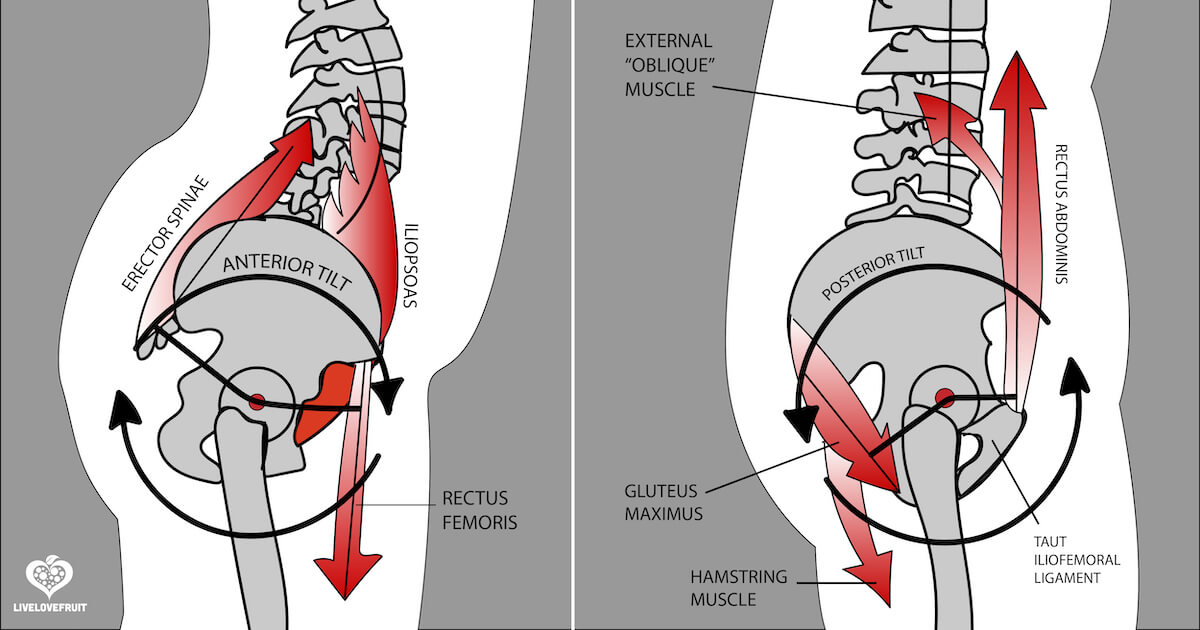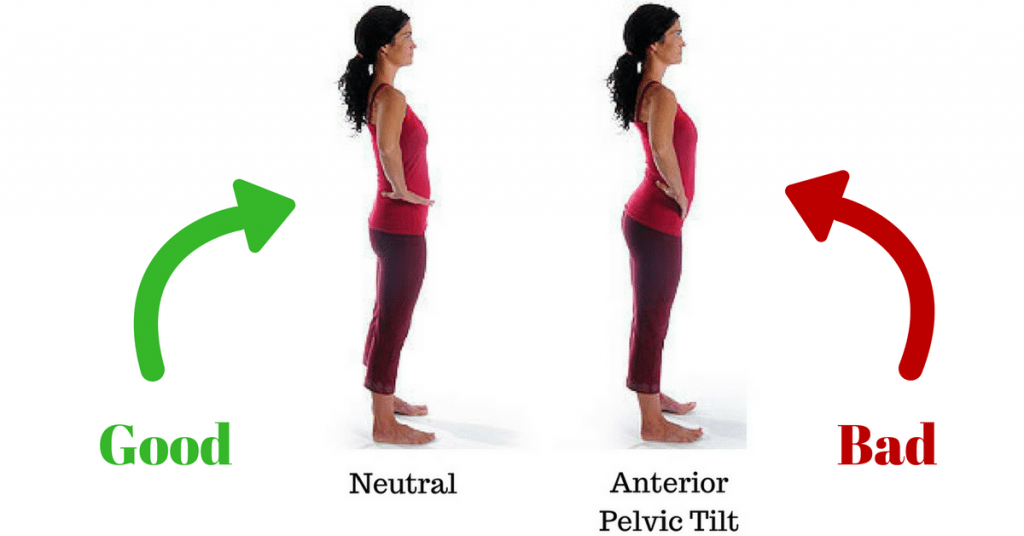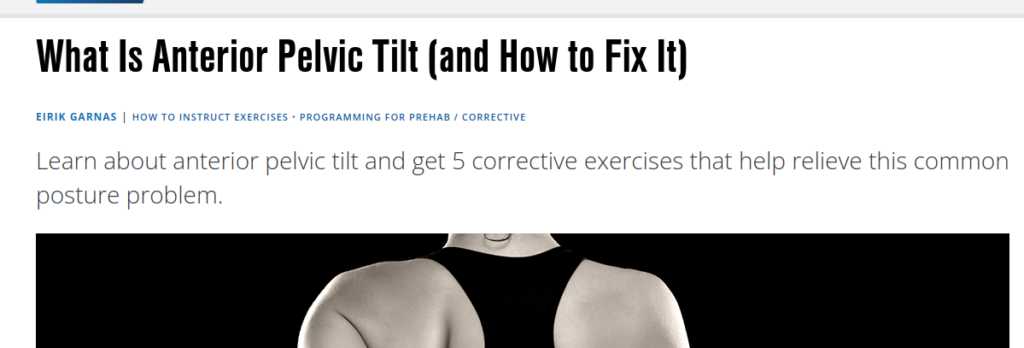So, your trainer/physio just told you you have an anterior pelvic tilt that needs to be corrected because it’s bad. OMG. You’re doomed! Right? Or… Maybe not? Is an anterior pelvic tilt actually bad? And posterior tilt good?

On the right: Posterior pelvic tilt (tailbone tucks down)
Repeat this as your mantra: There’s no such thing as an inherently good or bad movement.
Have you ever been told that you have the dreaded “anterior pelvic tilt”? And it’s the cause of all your body’s problems? I have. And I believed it, too.
Most of us have been taught that some movements are universally “bad” and we need to fix them. Anterior pelvic tilt is nothing more than three words describing a movement a healthy body should be able to do, not a life sentence to pain, misery, and moral judgement.
Don’t listen to Dr. Google
I did a Google search for the neutral term “anterior pelvic tilt” and the first result tells me it’s something I should care about correcting! WHAT??! What if I didn’t even know what a pelvis is, and now the first thing I’ve learned is that mine might be wrong…
Just check out these results from the frist page of Google:




Contrary to what you may read from Dr. Google about fixing your pelvis AT, any movement we avoid (deliberately or unconsciously) will limit us. Labelling movements as “bad” and avoiding them, our bodies will, ironically, become less free, less efficient, less flowing (and less fun!).
Pelvis anterior tilt is but one example. Another one is foot pronation. So is shoulder blade (scapula) protraction.
I, Monika (trust me, I’m a movement proefessional), hereby give you permission to do all of those things with your body, not that you need permission. In fact, I ask people to reclaim these “bad” movements in my Liberated Body Workshop.
Does an pelvis anterior tilt need correcting?
Now you know: No. Your body needs to be able to do an anterior tilt well, and do it with every step you take.
And there’s more to an anterior tilt of the pelvis is more than jamming your tailbone up to the ceiling. If it hurts your lower back to do an anterior tilt, you’re probably doing it wrong. Don’t avoid it, learn how to do one well.
Why?
You need an anterior tilt to load your extensor chain (glutes and hamstrings).
You need an anterior tilt to absorb shock through your hips and spine with each foot step.
And, you even need your pelvis to do an anterior tilt well if you want your jaw to be able to decompress. (Do you wear a night guard for bruxism? Hmm, maybe you’d like to assess your pelvic tilting as part of a hoistic strategy?)
The idea we need to “correct” a pelvis anterior tilt because it is bad and causes back pain is just an idea that is based on an incomplete, compartmentalized understanding of the body in motion. We can do better.
The truth? We need to be able to do an anterior tilt WELL just as we need to be able to do it’s opposite- posterior tilt, well. BOTH matter for the health of your hips, spine, and well, your whole body (and your life).
Think of it this way: If you could only choose to turn left or turn right for the rest of your life, which direction would you choose? Is one better than the other? Or would you like to do both? If Zoolander taught us one thing, it’s the pain of living a life with only the option to go right.
Case Study
A few days ago I worked with a client with lower back pain. He is a former high level curler 🥌. His back pain feels worse when he does a pelvis anterior tilt.
Traditional thinking would have us believe that we should avoid anterior tilting his pelvis like the plague and get him to squeeze his butt and tuck it under, right??
Not so fast…
As you’ll see in the video below, he actually has HUGE amounts of pelvis tuck-ability (posterior tilt). Wayyy too much. And you’ll hopefully see how it is dragging his spine backwards behind his feet and into a ton of flexion.
I’d also like you to observe how his pelvis anterior tilt pushes his whole torso forward, like a tree tipping over, putting his head well in front of his feet. This is the movement that is flagging up his back pain because he is shearing forward from one segment in his lumbar spine, instead of evenly articulating across all joints to make a healthy extension.
Check out the analysis I did below: Pelvis tilts BC (Before Cogs)
If you’ve been studying the newly released Anatomy in Motion online course from Gary Ward and co.: Closed chain upper body biomechanics in motion, then in the first chpater you will have learned that for healthy spine motion in upright gait we’d like to see your head stacked on top of your pelvis when it moves into AT and PT. Not swaying you forward and back like bamboo in the wind.
We call that stacked up pelvis on ribcage on skull organization on-axis. I also like to call it a shishkabob. Your spine is the stick. Mmm… Kebab…
In my clients’ case, his entire torso is being pushed forward by a pelvis anterior tilt, which shows us a few important things:
a) This person is not able to access an actual pelvis anterior tilt (and therefore there’s nothing to “fix”, it’s a movement to re-discover!)
b) This person probably has a imitation in intervertebral articulation into spine extension, which is needed to keep his head over his pelvis (actual movement between each individual joint in the spine, instead of being a tree trunk) This is important for spine health. And for giving the abdominal muscles something to do. Want abs? Add being able to anterior tilt to your list.
Now check out THIS second video, which I took after doing 10 minutes of corrective exercise to help him and his body re-learn what both pelvis anterior and posterior tilts with proper spine articulation feel like.
Pelvis tilts AC (AFTER Cogs)
Can you observe the cleaner pelvis and spine articulation, and less forwards/backwards swaying of his whole torso? He also reports no more back discomfort. Booyah!
What did we do?
Cogs: Our favourite exercise in AiM world. Which I’ve written about before.
Check out THIS video of me doing some floor cogs for an example of what I took my client through (or learn more in day 1 of Liberated Body with me :)).
And I can’t say enough about the Upper Body Biomechanics in Motion course, which has an amazing section on cogs if you’re an uber nerd and want the technical details.

Now, what is important to understand is that in the AFTER video, my client is not consciously trying to do “good” pelvis tilts because he now knows what it should look like.
I’m not saying, “Hey Bob, based on what I told you about pelvis motion, can you make that happen with your mind-power?”
I’m asking, “Hey Bob, show me what happens if you ask your body to tilt your pelvis both ways without over-thinking how you’re doing it”.
Can you appreciate the difference?
This is a representation of his body having better unconscious access to a new way of moving that takes LESS control, less forcing, less micromanaging, and less energy. More likely to happen naturally in each step.
What are the take-aways?
If anyone tells you that a movement is bad, don’t believe them. BUT, sometimes movements can become unhealthy- asymmetrical, excessive, too small, too slow, too fast, unorganized with the whole, etc- then we need to re-train the bdoy how to perform it, coordinated with the rest of the body.
Whhile a pelvis anterior tilt was a trigger for my client’s back pain, the “fix” wasn’t to eliminate pelvis anterior tilt from his life. The problem was that he couldn’t do one at all, and was shearing from his spine too much, instead.
Too much posterior tilt can be just as much of an issue as too much anterior tilt. My client in this post is is case in point.
We need our bodies to be able to access both posterior AND anterior tilts of the pelvis. Remember Zoolander.
The better we become at observing movement, the better was can get at finding solutions that help us reclaim our options for moving better.
So… how well can your pelvis move? 🤔
Want to learn more?
Movement myths abound in the worlds of fitness and therapy.
Knowing what a human body should be able to do and having a safe, non-judgemental space to explore how your body moves so you can understand what healthy movement feels like for you is so important for getting out of pain and optimizing performance.
Want to learn more about optimizing how your body moves, based on gait and the teachings of Anatomy in Motion? This is the kind of things I help folks with in Movement Detective School .
If you’re ready to stop wasting time with generic exericses and stretches, and you’re serious about learning how to undo the patterns you have adopted over the years due to past activities, sports, repetitive postures, injuries, and accidents, I’d love to work together on that 💪
I’ve dedicated the past 10 years of my life to learning how to get my body out of pain by exposing it to the truth of how our bodies move in gait, and I have so much about that process to share. Shoot me an email if you have any questions 🙂
Happy pelvis tiltin’.

